Maria Donovan's Blog
April 4, 2025
Last on the card – March primroses
The ancestors of these primroses jumped into a plant pot in Wales and made a journey…

The last photos I took in March were of primroses: the results are a bit shaky: I’m a little out of practice. That’s OK because I’m prompted by Bushboy’s Last on the Card challenge. And as you may know, the idea is to post, unedited, whatever you discover you’ve taken.
I haven’t posted at all for some while, as my main focus has been on writing, and my current WIP eats up most of my writing time. The story plays out in a world bereft of natural pollinators, so this month, I couldn’t resist showing a photo of precious primroses: to see them thriving gives me hope.
These primroses are mine, in the sense that they are the offspring of flowers that seeded into a large plant pot when I lived in Wales. They moved with me when I came back to Dorset. I love their spontaneous beauty – and how they multiply!
They’ve been been flowering in my garden since before Christmas. They must be hardy as they came through the few frosts we’ve had without trouble. In general, they are usually at their peak from March to May. It’s all happening a little earlier, these years. Mine have spread from the original few and spring up wherever they can. Along the path is a favourite spot, but I find them in odd places, growing in hardly any soil, and sometimes pot them on to give away in the hope that they will spread. Perhaps someone else will pot on the extras and give those away too.

These ‘common’ primroses (Primula vulgaris) are native to the UK and although there are many, there could and perhaps ought to be more. I would love to see primroses everywhere – in shady woods, green verges and all over people’s lawns. Have one plant and more will follow.
We took a neighbour out to look at them in their abundance, on banks by the roadside and in a quiet churchyard. I noticed that some had a green spot in the middle and have since found out, through Wildilfe Gardening Forum and elsewhere, that there are supposed to be two kinds: ‘pin-eyed’ and ‘thrum-eyed’. Only one kind is found on each plant and this is an aid to cross-pollination. The green pin in the pin-eyed type is the stigma: it’s at the top of the flower tube, while the anthers are lower down. In the thrum-eyed it’s the other way around and the anthers look like an orange ring. Can you tell which sort I have photographed?
Apparently, there is another type that is self-pollinating. According to an article in the New Scientist these produce more, but smaller seeds and are less successful than the cross-pollinating types, which produce fewer, but bigger seeds. Perhaps in the future, we’ll be glad that there’s a self-pollinating type.
Primroses are a valuable early source of nectar for bee-flies, and butterflies such as brimstone and small tortoiseshell. I prefer the native primrose, but last year, somehow there was cross-breeding with something else, and a double variety spontaneously appeared. Pretty, but I was alarmed in case all my native ones disappeared. I didn’t need to worry. Given the right conditions and some healthy neglect, your garden can have them in abundance too.
So, unless your lawn is meant for croquet or bowls, why not plant a few common (spectacular!) primroses in a shady spot or in a patch of earth in a border or just in pots – and have the joy of seeing them spread? The countryside around me is green – but that’s mainly grass. Wherever we can, let’s nurture the wild flowers we have and see if we can have them in abundance again, and help nature’s pollinators too, on which we all depend.
June 8, 2024
River Brit
The last photo for May is of the River Brit. A place full of memories, but always changing.
The Last on the Card photo challenge is easy, inclusive and often surprising! Have a look at our host Bushboy’s post here for the rules. In short, just find the last photo(s) you took in May, unedited, and link to his post.
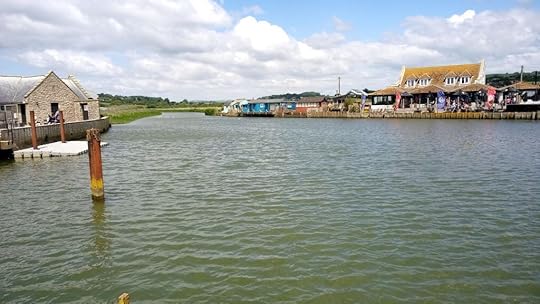
31st May: a chilly wind blowing in West Bay. This is taken from the bridge over the sluice gates that divide the River Brit and its pool from the harbour. On the left, the Salt House. On the right, Rise café (for years before this known as ‘the Riverside’). Ahead is the blue cabin that became David Tennant’s ‘home’ (as DI Andy Hardy) in the second series of ‘Broadchurch‘. The link takes you to a page about the Dorset locations for the three TV series, which writer Chris Chibnall called ‘a love letter to the Jurassic Coast’. The actual location for the town of ‘Broadchurch’ as shown in the series, is Clevedon, many miles away, in North Somerset.
The series was filmed again for the US market as ‘Gracepoint’. This TV mini-series also starred David Tennant, this time as Detective Emmett Carver. Critics who didn’t like him switching to an American accent had probably forgotten that he’s a Scot, and that he’s acting when he puts on an English accent.
But back to the photo: from here, you can take a boat upstream through meadows and under the bypass bridge to Palmer’s brewery, where the water runs shallow. Above this is a weir (featured in my novel, The Chicken Soup Murder). The weir marks the confluence of two rivers: the Brit and the Asker, which pass either side of the oldest part of Bridport.
I often take a picture of this view: it’s hard to resist, even on a grey day. It holds for me a host of memories and associations – and a sense of the past far beyond memory, when Viking raiders came up-river between the whispering reeds.
Thanks as always to Brian for hosting the Last on the Card photo challenge! I love to see what people are posting from all over the world.
Words are not necessary, but I can’t resist.
April 4, 2024
Happy Publication Day!
Spring seems the perfect time for my story ‘Narcissus’ to make its appearance, just one of the fourteen offerings in Botanical Short Stories, edited by Emma Timpany. Out today, 4 April 2024!
Published by The History Press with illustrations by Sarah Jane Humphrey, the anthology ‘celebrates the deep connection that exists between people and plants in fourteen short stories as varied, diverse, and global as the botanical world itself’.
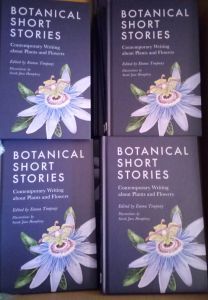
The official launch takes place on Thursday 2 May 2024 at 6pm with free entry at the Falmouth Bookseller, as part of the Wayward Book Festival. I know that the amazing Diana Powell has a launch clash as her new novel The Sisters of Cynvael is being celebrated on the same day, but Emma and Sarah will be there to talk about the anthology and other contributors (including myself) might be present – to be confirmed!
Copies of our beautiful hardback anthology, priced £14.99, will be available on the night. Otherwise you can order from your favourite bookshop and all the usual places.
If you would like a copy signed by me please get in touch by email or via the Contact page.
In case you’re wondering what kind of story ‘Narcissus’ might be, here’s an extract from a review in Hortus:
‘Maria Donovan’s “Narcissus” unfolds in a Dutch bulb factory. Here, we are introduced to the itchy and arduous work that goes into packing the thousands of daffodil, tulip and hyacinth bulbs which are shipped to the UK, and we glimpse some of the human stories that might be found there.’
While ‘Narcissus’ is a fictional story, I’ve drawn on real experiences of that working environment and on what it’s like to be an immigrant, trying to make new connections.
Happy reading!
April 3, 2024
Blurry Bunnies!
The Easter table is my Last on the Card for March. Following the guidelines set by Bushboy I’m posting this unedited. As you can see, it isn’t properly in focus. You can do better!
Due to…circumstances, I haven’t posted for a while. No last photos for January or February. I nearly didn’t join in this time either (I think you can see why) but in the spirit of Brian’s all-inclusive challenge I’m sharing the last photo I took in March with my phone.
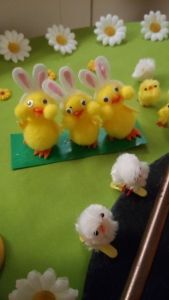
Easter is a moveable feast so this year it managed to fall on the last day of March just as the clocks changed. In the Northern Hemisphere we are officially in Springtime: Meteorological Spring begins on the 1 March and Astronomical Spring on the Equinox.
Friends in the Southern Hemisphere, Bushboy included, are heading for shorter days. Warm wishes to everyone! Or if it’s getting too hot for you, stay cool.
Have a look at Brian’s post via the link at the top. He has three photos to share (oh the Moon!) and you’ll see the simple guidelines explained. I look forward to seeing your photos!
.
January 1, 2024
Sunset on 2023
This is my last photo for December: a timely goodbye to 2023, and my offering for Bushboy’s Last on the Card photo challenge.
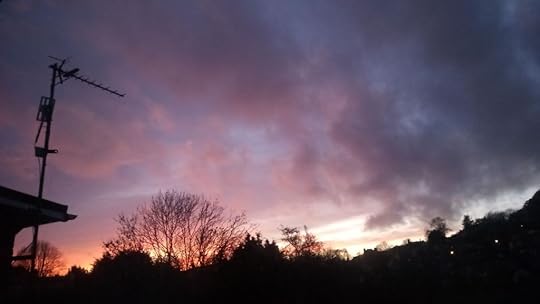 [image error] [image error]
[image error] [image error] My last photo was taken between Christmas and New Year from a back window. We’ve had so much rain here I was excited to see red sky at sunset! The clouds had a wild painterly quality and knowing the effect wouldn’t last long I was glad to get any kind of photo with my phone camera.
New Year is the third mass experience marking for me the turning of the year, following on from the Solstice and Christmas Day; it’s as if I need telling three times before it sinks in.
The Solstice makes perfect sense, never more clearly than when I lived in Wales, near Aberystwyth, 1000 feet up, and observed the sunset moving along the sea horizon every evening from one fixed point to another and back again.
Christmas – whatever you think of it, it can be hard to avoid!
But New Year is something else: calendar dates are strange and it gives me a funny feeling to know that with a tick of the clock, 2023 is no longer part of the present. It is now just another of the years that belong to the book of the past.
I’ve been thinking a lot lately about moments: how each one is significant in its own way and never to be relived. Time seems to speed up as I get older; maybe because most physical tasks are taking longer, maybe because the whirl of years is making me giddy.
However you feel about the passing of the Old Year and the Welcoming of the New, if you want to take part in Brian’s inclusive photo-challenge please check the link above for the simple what to dos.
If you share my fascination with the calendar and the ways in which we count time, have a look at this post about January and Janus: the god with two faces, one looking back, the other ahead; also the god of archways and doors.
However you navigate time, I wish you all peace, happiness and good health from moment to moment.
December 21, 2023
Unseasonable
Christmas music, fairy lights and – cherry blossom?
In about twelve hours it will be the Winter Solstice: December here in the week before Christmas is all twinkly lights and seasonal music; completely unseasonal is the blossoming of this local ornamental cherry.
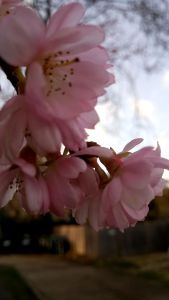
This tree, which stands alone, has always flowered much earlier than a line of other ornamental cherries round the corner, perhaps because, unlike them, it’s sheltered from the prevailing wind. Until now though, its pink blossom has always been a welcome sign of Springtime. I’ve never seen it in flower on the wrong side of Christmas – until today.
Here the weather has mostly been mild and wet, more like a soggy March or early April than December. We’ve had one brief spell of frosty nights and mornings, which lasted two or three days. Maybe the tree noticed that it’s been consistently mild after a period of cold and thought it was worth a chance. These observations of the first or the last of something in nature can be very useful in indicating how things have changed, and are changing still.
Every Sunday morning I listen to a radio programme from the Netherlands called Vroege Vogels /Early Birds’ (in my opinion, worth learning Dutch for). It starts at 7am Dutch time and 6am here. It’s all about nature (with interludes of classical music); one of the high points for me is the Fenolijn. Phenology is the recording and study of things happening in the natural world particularly in relation to the seasons. The Fenolijn features a selection of voices from among the many listeners to the programme, including children, who have called in and left a message that week, describing something they have observed. In Autumn there were quite a few reporting their astonishment at seeing their apple trees in bloom or that the local blue tits had risked bringing forth one more brood, or the presence of what must surely be the very, very last swallow.
Those chosen for broadcast are among hundreds of witness statements, which are hugely informative in helping to see trends and changes due to alterations in the climate or ecology of a place. There is much joy in experiencing nature, I think, but also warnings.
Phenology combines ecology and meteorology and those who have recorded their observations in the past are providing valuable insights today. This is one reason why I like to be accurate about these things in fiction. I don’t know if anyone else cares, but the weather in my novel The Chicken Soup Murder is the weather and the events are the events, in nature and in the news, because I kept a detailed record of what was going on and how it could affect my character’s story unfolding in a real place in real time.
But without having to be a novelist or a scientist, anyone can keep a record of things they observe and when and where. Post a photo on Instagram and you’re already recording something. But if you want to contribute to more directed study, then here in the UK you can also add a record of something you have noted in nature to the Woodland Trust’s Nature Calendar. The more observations the better, I think, to contribute to a realistic picture of how things are, whether things are happening earlier, later or quite out of season.
Will we have to change our ideas, when we have cherry blossom at Christmas instead of snow? In Dorset we often have mild wet winters, whereas for the Dutch it might be colder on the whole, with their edge of continent climate, but that doesn’t mean there will be endless stretches of frozen water to skate on in the Netherlands. You perhaps don’t know how many people there feel sore at heart because this might be yet another winter with no race on ice around the 11 towns – not if recent past winters are anything to go by.
Are you a phenologist? Have you noticed anything unseasonal where you live?
I am interested to know how all of these observations of the very local combine into a global picture. Any thoughts?
If you know of a means by which people can report their observations in your country, similar to the Fenolijn or the Woodland Trust page, please let us know in the comments. I’m interested!
December 10, 2023
Turning the tide
I was just in time to add my contribution to the December Poetry Challenge from Fake Flamenco. The challenge was to write using the Japanese form; dodoitsu.
As the original post by Rebecca Cuningham explains the dodoitsu is ‘non-rhyming, with a humorous twist…four lines: 7 syllables, 7 syllables, 7 syllables, 5 syllables’. Here is my post with the photo that inspired it. The theme was ‘turn’.
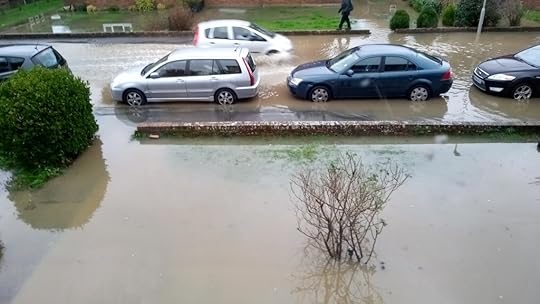
The road floods, air feels so damp
Our dehumidifier
Collects moisture for us to
Pour back down the drain
I’m writing a novel these days, weeks and months (all right, years) and it gives me pleasure to play a game like this: I enjoy counting the syllables and making it fit and coming up with something without feeling that it has to speak for my entire being and worth as a writer.
In other words, it’s fun. Thanks, Rebecca!
The photo was taken last Monday just before the sandbags came out. This driver was considerate and went slowly. Here’s a photo of what happens when you drive fast! Apart from drenching pedestrians it sends big waves across the gardens, swooshing flood water ever closer to people’s doorways.
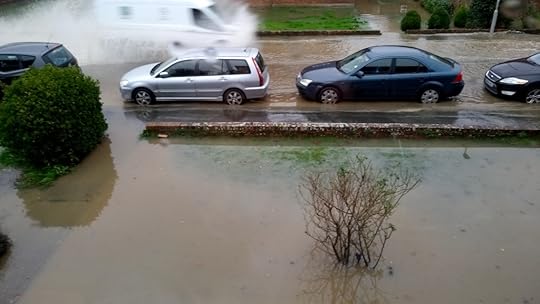
One of the exciting and special things about Rebecca’s site is that she writes in Spanish and English and offers translations of the poems submitted to the challenge. Looking forward to that. What a great way to explore languages!
If you want to read some of the other poems posted on Rebecca’s page – see the link at the top. If you like the idea of trying a challenge like this I think there’ll be a chance again in January…Maybe see you there?
And in the meantime are there any other poetry challenges you follow?
December 1, 2023
White-out on Black Down
The view from Hardy’s monument in Dorset is best known for its breath-taking panorama…
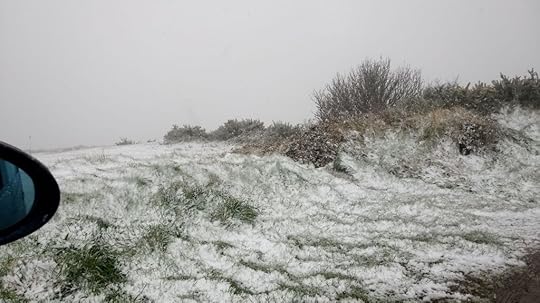
There’s a saying enjoyed by people on the Dorset coastline: if you can’t see the Isle of Portland it must be raining; if you can see Portland, it’s about to rain. On the last day of November we had snow, which only settled on the highest ground.
As we were travelling back from Dorchester to Bridport by the scenic route, we stopped on the top of Black Down by the monument to Thomas Hardy. The view from this angle on a clear day takes in the Fleet Lagoon and Chesil Bank to Portland and beyond, all the way to the distant Isle of Wight. As you can see, it’s totally obscured. It was wild up there, with a driving wind from the North. Beautiful in its own way.
I might have posted this one anyway but it’s also my last photo for November so for once I am getting in early with my contribution to Bushboy’s ‘Last on the Card’ photo challenge. You too can join in: it’s wonderfully inclusive. Surprise yourself by revealing your last photo for the month, unedited. Doesn’t matter if it’s odd or blurry. You don’t even need to comment (I just can’t help myself). To check out the simple rules and see Brian’s photos, and all the others linked to it, go to Bushboy’s blog here.
In case you’re wondering why there is a monument to Hardy in such a high place…Read on.
The main thing to remember is that, where other Counties lack a famous man called Thomas Hardy, Dorset has two. One, the novelist and poet who wrote Tess of the D’Urbervilles and ‘The Darkling Thrush’; the other, Vice-Admiral Sir Thomas Masterman Hardy, Flag Captain of HMS Victory at the Battle of Trafalgar. He held the dying Nelson in his arms and he would have known whether or not Nelson said the famous words, ‘Kiss me, Hardy.’
This is his memorial, supposedly in the form of a spyglass. It has been a landmark for shipping since it was erected in 1844. It’s also visible for miles around in the countryside – so you can see where you’re heading, as long as it isn’t obscured!
For a view of the monument itself or to know more about its history and the nature that surrounds it, for the many fine walks you can take from this point along the South Dorset Ridgeway or for more views along and beyond the Jurassic Coast (as we call it, since it became a World Heritage Site) check out these links:
Black Down and Hardy’s Monument – Dorset national landscape
And finally: will you take up Bushboy’s photo challenge and share your last photo for November? Have you seen snow yet? Or is it summer where you are?
November 10, 2023
Eyeballing the Moon
Not every Full Moon drops so neatly into the giant’s eye socket. Maybe he’s going to wake up…
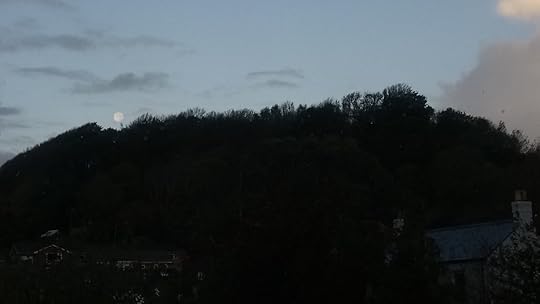
I saw a late October post by Brian @Bushboy’s World with some spectacular photos of the Moon – and also one that was the kind of ‘white blob’, which is all I have ever managed. I felt encouraged to keep trying! And by chance my last photo for October was this one – taken with my camera phone one morning.
I’ve taken many photos of this hill – the view from my kitchen window – and it often makes me think of the head of a sleeping giant.
So I couldn’t help feeling excited when October’s Full Moon dropped so neatly into the giant’s eye socket. I had to try and get a photo. It took a little patience to wait for it to line up, but it’s surprising how fast that setting Moon can move! While I have captured the moment, I know I really need to work on my technique (and/or use a better camera). Meanwhile, I admire other people’s photos.
For me, the lovely thing about Brian’s Last on the Card challenge is that you can post your last photo for the month gone by, whatever it is, unedited, however bad or good, and even without comment (I rarely manage that but then words are my thing).
If you want to try this super-inclusive photo challenge you’ll find the simple rules here at Bushboy’s blog along with links to many beautiful and unusual photos taken by Brian and his followers. Hope to see you there!
October 6, 2023
Ticking off September
Once again I take camera phone and laptop in hand to join in with Bushboy’s Last on the card photo challenge. Always a surprise…
I was expecting some kind of pale food. On Saturday 30 September I was preparing for another procedure and had to eat the kind of diet I’d usually label ‘unhealthy’: lovely soft white bread and white rice. No vegetables, no fibre, no nuts. Nothing with bits in it.
Instead, I find I’ve taken a photo of the kitchen clock. Maybe to remind myself that I was not allowed to eat anything after 3pm (and for the next 24 hours).
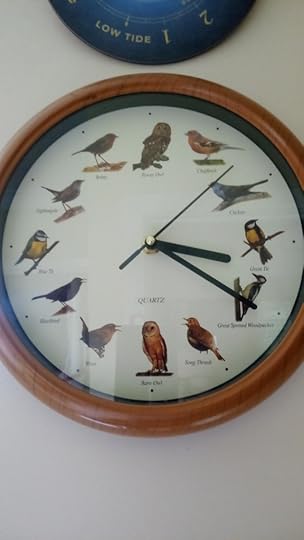
It seemed best to stay away from the kitchen after that in case food of any kind jumped into my mouth.
Just above the bird clock is part of the tide clock, which is surprisingly accurate. The bird clock keeps good time and is supposed to sing or call on the hour with a succession of different noises.
Disappointingly, none of the sounds it makes are anything like the birds they represent. I think we were expecting a recording and not some strangled electronic noise. Luckily, you can take the batteries out for that bit and still have a working clock, which ticks the time away.
24 hours soon went by and by the evening of 1 October I was home again. I want to repeat my thanks to everyone I saw at Dorchester County Hospital that day for carrying out investigations like this on a Sunday!
If you want to join in with bushboy’s Last on the Card challenge have a look at his post here. It’s a nice photo challenge for amateurs like me, as the idea is to post your unedited last photo(s) for the month just gone by. No comments are required. Some of us just can’t help ourselves…



